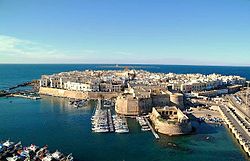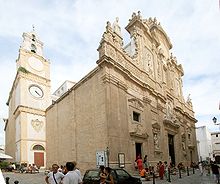Gallipoli
| |
|---|---|
| Comune di Gallipoli | |
 Gallipoli panorama | |
 Gallipoli within the Province of Lecce | |
| Coordinates: 40°03′20″N 17°59′30″E / 40.05556°N 17.99167°E | |
| Country | Italy |
| Region | Apulia |
| Province | Lecce (LE) |
| Frazioni | Baia Verde, Lido Conchiglie, Lido San Giovanni, Rivabella, Torre del Pizzo |
| Government | |
| • Mayor | Stefano Minerva |
| Area | |
| • Total | 41.22 km2 (15.92 sq mi) |
| Elevation | 12 m (39 ft) |
| Population (31 October 2021)[2] | |
| • Total | 19,536 |
| • Density | 470/km2 (1,200/sq mi) |
| Demonym | Gallipolini |
| Time zone | UTC+1 (CET) |
| • Summer (DST) | UTC+2 (CEST) |
| Postal code | 73014 |
| Dialing code | 0833 |
| Patron saint | St. Sebastian, St. Agatha, St. Christine |
| Saint day | January 20 |
| Website | Official website |




Gallipoli (Italian: [ɡalˈliːpoli]; Salentino: Caḍḍìpuli [kaɖˈɖiːpʊlɪ]; Ancient Greek: Καλλίπολις, romanized: Kallípolis, lit. 'Beautiful City') is a southern Italian town and comune in the province of Lecce, in Apulia. In 2014, it had a population of 31,862[2] and is one of the towns where the Greek dialect Griko is spoken.
Geography[edit]
The town is located by the Ionian Sea, on the west coast of the Salento Peninsula. The town of Gallipoli is divided into two parts, the modern and the old city. The new town includes all the newest buildings including a skyscraper. The old town is located on a limestone island, linked to the mainland by a bridge built in the 16th century.
The municipality borders with Alezio, Galatone, Matino, Sannicola and Taviano.[3] It counts the hamlets (frazioni) of Baia Verde, Lido Conchiglie, Lido San Giovanni, Rivabella and Torre del Pizzo.
History[edit]
According to a legend, the city was founded in ancient times by Idomeneus of Crete. Pliny the Elder attributes the foundation to the Senones Gauls, while more likely it was a Messapic settlement. Historically, what is known is that Gallipoli was a city of the Greater Greece, ruling over a large territory including today's Porto Cesareo. In 265 BC it sided with Pyrrhus and Taranto against ancient Rome, suffering a defeat which relegated it to a Roman colony (later a municipium).
In the early Middle Ages, it was most likely sacked by the Vandals and the Goths. Rebuilt by the Byzantines, Gallipoli lived an economically and socially flourishing period due to its geographical position. Later it was owned by the Roman Popes, and was a centre of fighting against the Greek monastic orders.
In the 11th century Gallipoli was conquered by the Normans and, in 1268, it was besieged by Charles I of Anjou, causing numerous inhabitants to flee to the nearby Alezio. The city was repopulated around 1300, under the feudal rule of the principality of Taranto. In 1484 the Venetians tried to occupy it, but without results. King Ferdinand I of the Two Sicilies started the construction of the port, which in the 18th century became the largest olive oil market in the Mediterranean.
After the unification of Italy (1861), Gallipoli was capital of a circondario, together with Lecce and Taranto.
Main sights[edit]
- Angevine-Aragonese Castle, built in the 13th century by the Byzantines. It was largely remade under the Angevins and the Aragonese, who added a polygonal wall fortified with round towers. The main additions were carried on by Francesco di Giorgio Martini, who worked for King Alfonso II of Naples. In 1522 an eastern bastion, known as Rivellino, was built which is defended by waters on three sides.
- 14th century walls (renewed by the Spaniards in the 16th century). Originally they had 12 towers or bastions.
- Baroque Cathedral of Sant'Agata (17th century). It has a richly decorated façade in carparo, a local limestone, with niches featuring statues of saints. The interior is on the Latin cross plan, with Baroque altars, including a polychrome high altar by Cosimo Fanzago.
- Church of St. Francis of Paola (1621)
- Church of St. Francis of Assisi, built in the 13th century but renovated several times later. It is home to a stone nativity scene by Stefano da Putignano (late 16th century)
- Church of San Domenico al Rosario (late 17th century), annexed to a former Dominican convent.
- Church of the Holy Crucifix (1750)
- Church of Santa Maria della Purità (1661). The richly decorated interior houses, at the marble high altar, a canvas by Luca Giordano depicting the Madonna della Purità between st. Joseph and St. Francis of Assisi.
- Greek Fountain (16th century), once believed to date to the 3rd century BC. It has bas-reliefs with mythological figures and, on the other façade, the insignia of Charles III of Spain.
- Palazzo Pirelli (16th century), with mythological-theme decorations in the vault of former entrance archway which was converted to a pharmacy in the 19th century.
- Church of San Pietro dei Samari, outside the city. It was built in by a Crusader knight, Ugo di Lusignano in 1148.
- Spiaggia la Puritate beach under the city walls.
Transportation[edit]
Nearest airports are Brindisi, 88 kilometres (55 mi), and Bari, 200 kilometres (120 mi). Gallipoli can be reached from both of them via a freeway, the state road 101.
By train, it is connected to Lecce by the Ferrovie Sud-Est.
Economy[edit]
In past times the economy of Gallipoli was based on the international wine and oil commerce. Nowadays its most important activities are based on fishing and tourism.
Tourism is enjoyable throughout the year, due to the mild climate. Numerous festivals, both civil and religious, are also held. These include the Carnival, Easter and all the parades, Sant'Agata, and the Santa Cristina celebrations in July.
Gallipoli also boasts a very recently built harbour for private boats, located just steps from the bottom of the main Corso Roma.
The summer season starts in May and ends in October, when the weather is almost invariably hot and clear.
LGBT culture[edit]
A sophisticated gay scene has developed around Gallipoli, often referred to as “Gay-lipoli”. The city is particularly well known as a destination for the Italian gay population [4] and has become “Italy’s gay summer paradise”.[5] A vibrant nightlife means Gallipoli draws an international gay crowd over the summer months, with visitors also being drawn by the nearby naturist beaches and the popular lidos at Baia Verde.
Sport[edit]
The local football team is the Gallipoli Calcio. The team won the 2005–06 Serie C2/C championship. They were promoted to Serie B for the first time in the club's short history after winning the 2008–09 Serie C1/B championship, although were instantly relegated and then refounded due to financial issues.
International relations[edit]
Gallipoli is twinned with:
 Monfalcone, Friuli-Venezia Giulia, Italy
Monfalcone, Friuli-Venezia Giulia, Italy Catania, Sicily, Italy
Catania, Sicily, Italy
See also[edit]
- Roman Catholic Diocese of Gallipoli
- Roman Catholic Diocese of Nardò-Gallipoli
- Diocesan Museum of Gallipoli (Italy)
- Isola Sant'Andrea Lighthouse
References[edit]
- ^ "Superficie di Comuni Province e Regioni italiane al 9 ottobre 2011". Italian National Institute of Statistics. Retrieved 16 March 2019.
- ^ a b (in Italian) Source: Istat 2014
- ^ 40209 Gallipoli on OpenStreetMap
- ^ "Off the gaydar". The Guardian. 20 June 2009. Retrieved 22 September 2020.
- ^ "The Big Gay Puglia FAQ". The Big Gay Podcast from Puglia. Retrieved 22 September 2020.
External links[edit]
- Official website (in Italian)
- Anxa News (in Italian)




